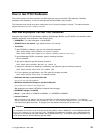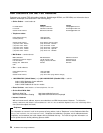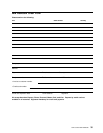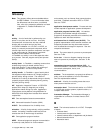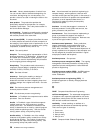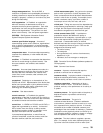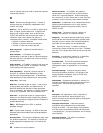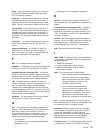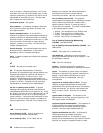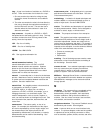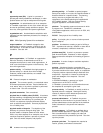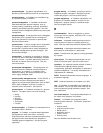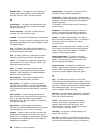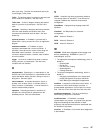when a customer places an order to when the customer
receives the product).
D
DASD. Direct Access Storage Device. A device in
which access time is effectively independent of the
location of the data.
data bus. On an ALOVC or a LLOVC, a logical set of
data. A logical, dynamic data store. It Starts at the
beginning of a logical model, such as ALOVC and
LLOVC and continues until the end of the model. It
reflects the most current data at any point in a
relationship with a customer. Examples of data buses:
Contact or customer data bus
Offering or products and services data bus
Promise or order and contract data bus
data component. A packet of data with which a
process deals.
data connector. In FlowMark: the graphical
representation of the flow of data in a process diagram.
See also
data flow, information flow, control connector
,
and
default connector
.
data container. In FlowMark: storage for the input and
output of an activity, a block, or a process. See also
input container
and
output container
.
data dependency. Data that a process requires to
proceed. An
upstream data dependency
is data
required from the preceding process. A
downstream
data dependency
is data required by the next process.
data entity. See
entity
.
data flow. A packet of data in motion. It can consist
of data groups, data entities, and data elements. A
data flow identifies the data that is either generated
from or required by, the customer or internal processes
to which it is connected. See also
information flow
.
data store. A logical set of data or a physical place
where you can keep information (desks, filing cabinets,
databases, and personal computer files are examples of
physical
data stores).
DB2/2. IBM Database 2 for OS/2, a relational
database manager.
DDE. Dynamic data exchange. An OS/2 or Microsoft
Windows feature that enables data exchange between
applications.
decomposition. The process of breaking a large entity
into smaller components. For example, a process can
be decomposed into subprocesses, or an activity into
tasks.
default connector. In FlowMark: the graphical
representation of a special kind of control connector,
shown as in a process diagram. Control flows along
this connector if no other control path is valid. See also
connector, control connector
, and
transition condition
.
department. A subdivision of an enterprise that shows
reporting lines and performs one or more activities.
Department is part of the physical models, such as
PLOVC or HSD.
design point. The primary focus of a design; for
example, the customer, or a workflow solution.
designing. The creative process used to plan, sketch,
and model the new business processes, process paths,
and jobs in order to create a set of detailed blueprints
from which the new design can be implemented.
DLL. Dynamic link library. A module containing a
routine that is linked at load time or run time. FlowMark
uses the *.DLL filetype under OS/2 as well as under MS
Windows.
document. A transmission medium for, or depository
of, information, such as a report or an invoice.
document flow. The flow of documents through an
organizations. This can be through a document
management system in digitized form or in hardcopy
form.
document storage. A physical data store where
hard-copy documents are stored. Can be part of the
physical models or blueprints, such as PLOVC and
JLOVC. See also
data store
.
downstream. Subsequent processes or activities, for
example the
distribute
process is downstream from the
order
process. See also
data dependency
and
upstream
.
E
enterprise. An organization, usually comprised of
several lines of business, whose purpose it is to
perform a mission and to achieve goals by working with
customers and suppliers.
enterprise architecture. A business process
architecture at the enterprise level as expressed
through an ALOVC. It is at the logical, unconstrained
level and shows the essential process and data needs
in sequential form. See also
architecture line of visibility
chart (ALOVC)
.
enterprise process. The actions or processes
performed by the enterprise.
40 FlowMark V2.3 Design Guidelines




